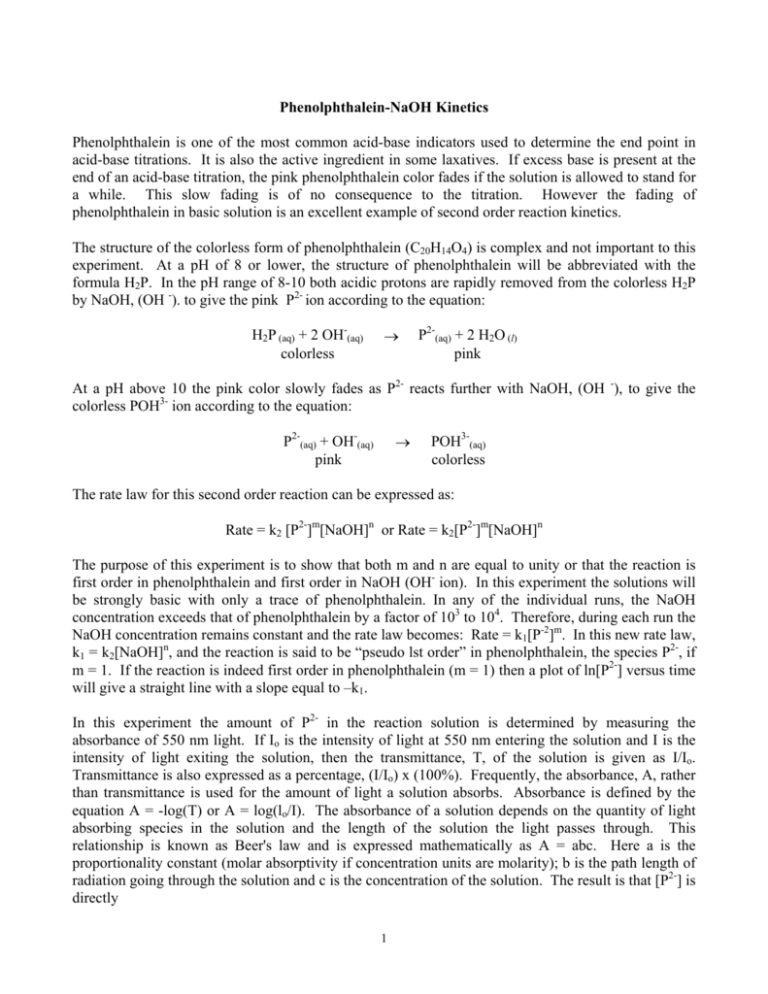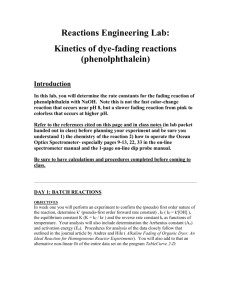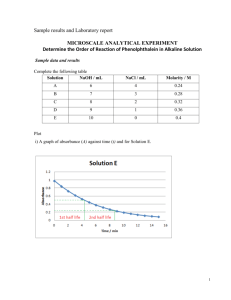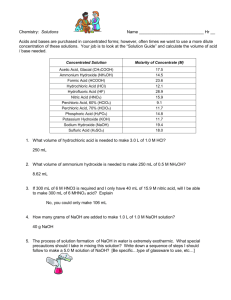Phenolphthalein-NaOH Kinetics Phenolphthalein is one of the most
advertisement

Phenolphthalein-NaOH Kinetics Phenolphthalein is one of the most common acid-base indicators used to determine the end point in acid-base titrations. It is also the active ingredient in some laxatives. If excess base is present at the end of an acid-base titration, the pink phenolphthalein color fades if the solution is allowed to stand for a while. This slow fading is of no consequence to the titration. However the fading of phenolphthalein in basic solution is an excellent example of second order reaction kinetics. The structure of the colorless form of phenolphthalein (C20H14O4) is complex and not important to this experiment. At a pH of 8 or lower, the structure of phenolphthalein will be abbreviated with the formula H2P. In the pH range of 8-10 both acidic protons are rapidly removed from the colorless H2P by NaOH, (OH -). to give the pink P2- ion according to the equation: H2P (aq) + 2 OH-(aq) colorless → P2-(aq) + 2 H2O (l) pink At a pH above 10 the pink color slowly fades as P2- reacts further with NaOH, (OH -), to give the colorless POH3- ion according to the equation: P2-(aq) + OH-(aq) pink → POH3-(aq) colorless The rate law for this second order reaction can be expressed as: Rate = k2 [P2-]m[NaOH]n or Rate = k2[P2-]m[NaOH]n The purpose of this experiment is to show that both m and n are equal to unity or that the reaction is first order in phenolphthalein and first order in NaOH (OH- ion). In this experiment the solutions will be strongly basic with only a trace of phenolphthalein. In any of the individual runs, the NaOH concentration exceeds that of phenolphthalein by a factor of 103 to 104. Therefore, during each run the NaOH concentration remains constant and the rate law becomes: Rate = k1[P-2]m. In this new rate law, k1 = k2[NaOH]n, and the reaction is said to be “pseudo lst order” in phenolphthalein, the species P2-, if m = 1. If the reaction is indeed first order in phenolphthalein (m = 1) then a plot of ln[P2-] versus time will give a straight line with a slope equal to –k1. In this experiment the amount of P2- in the reaction solution is determined by measuring the absorbance of 550 nm light. If Io is the intensity of light at 550 nm entering the solution and I is the intensity of light exiting the solution, then the transmittance, T, of the solution is given as I/Io. Transmittance is also expressed as a percentage, (I/Io) x (100%). Frequently, the absorbance, A, rather than transmittance is used for the amount of light a solution absorbs. Absorbance is defined by the equation A = -log(T) or A = log(lo/I). The absorbance of a solution depends on the quantity of light absorbing species in the solution and the length of the solution the light passes through. This relationship is known as Beer's law and is expressed mathematically as A = abc. Here a is the proportionality constant (molar absorptivity if concentration units are molarity); b is the path length of radiation going through the solution and c is the concentration of the solution. The result is that [P2-] is directly 1 proportional to the absorbance A of the solution at 550 nm. Thus a plot of ln(A) versus time will give a straight line if the reaction is first order in P2- and its slope will be -k1. The rate law is then: Rate = k2 (Absorbance)m [NaOH]n By measuring the reaction rate at several different concentrations of NaOH, it can be shown that the reaction is first order in NaOH and the rate constant, k2 can be evaluated. k1 = k2[NaOH]n if n = 0, then k2 will equal k1 for all four runs. If n = 1 then k2 equals k1 divided by [NaOH] and k1/[NaOH] will be constant for all four runs. If n = 2 then k2 equals k1 divided by [NaOH]2 and k1/[NaOH]2 will be constant for all for runs. Thus the reaction order in NaOH can be determined. EXPERIMENTAL PROCEDURE Preparation of Standard Solutions Some measurements in this experiment are not particularly critical; other measurements must be determined accurately. The exact concentration of the initial phenolphthalein solution and the exact time of mixing are not critical. What is important is knowing the concentration of the initial NaOH solution, making dilute NaOH solutions very accurately, measuring the time intervals between absorbance readings accurately, and keeping the total ion concentration (the ionic strength) of all the runs constant. The last factor is important because the reaction rate depends on the ionic strength of the solution since the reaction involves the approach of two negatively charged ions and their mutual repulsion is decreased in an environment containing inert (spectator) ions. A constant ionic strength will be maintained in the solutions by substituting 0.300 M NaCl for 0.300M NaOH. Standard Phenolphthalein Solution: Dilute one mL of a phenolphthalein solution with 4 mL of ethyl alcohol. Standard 0.300 M NaOH Solution: Weigh 1.200 grams of concentrated NaOH solution (50% NaOH by mass) solution into a 50 mL beaker and transfer it to a 50 mL volumetric flask. Rinse the beaker several times with distilled water and pour that solution into the volumetric flask. Dilute to the mark with distilled water. Standard 0.300 M NaCl Solution: Weigh out 0.878 grams of NaCl in a 50 mL volumetric flask. Add a small amount of distilled water, swirl to dissolve the salt and then dilute to the mark with distilled water. Calibration of the Spectronic Spectrophotometer: Set the wavelength knob to 550 nm. With no cuvette in the cell compartment, use the left dial to set the meter to zero % transmittance. Fill a clean cuvette with distilled water and place in the cell compartment. Adjust the % transmittance to read 100 % using the right dial. Do not touch the wavelength, zero percent and 100% dials once the instrument is calibrated. 2 Kinetic Runs Run No. 1: Fill a cuvette to the B & L mark with 0.300 M NaOH, add one drop of phenolphthalein solution, and invert to mix the solutions. Place the cuvette in the Spectronic 20. Readings of absorbance vs time should begin when the absorbance value reaches 0.60. If the initial absorbance is over 0.60 leave the cuvette in the Spectronic 20 and wait until the reading drops to 0.60. If the initial absorbance is below 0.60 remove the cuvette, add another drop of phenolphthalein solution and invert to mix. Reinsert the cuvette and wait until the absorbance drops to 0.60. Start your timing when the absorbance is 0.60. Zero time is when you take your initial absorbance reading. Record the absorbance every 0.50 minutes after your initial reading for a total of 3.0 minutes. Run No. 2: Prepare 0.200M NaOH by pipetting 20 mL of 0.300 M NaOH solution into a small beaker and pipetting 10 mL of 0.300 M NaCl into it. Fill a cuvette to the B & L mark with the resulting 0.200 M NaOH solution, add one drop of phenolphthalein solution and invert to mix. Place the cuvette in the Spectronic 20 and start your measurements when the absorbance is 0.60. Take readings every 1.0 minutes for a total of 6.0 minutes. Run No. 3: Prepare 0.100M NaOH by pipetting 10 mL of 0.200 M NaOH into a small beaker and pipetting 10 mL of 0.300 M NaCl into it. Fill a cuvette to the B & L mark with the 0.100 M NaOH solution, add one drop of phenolphthalein solution, and invert to mix. Place the cuvette in the Spectronic 20 and start absorbance readings when the initial value reaches 0.60. Take subsequent absorbance readings every 2.0 minutes for a total of 12 minutes. Run No. 4: Prepare 0.0500M NaOH by pipetting 10 mL of 0.100 M NaOH into a small beaker and pipetting 10 mL of 0.300 M NaCl into it. Fill a cuvette to the B & L mark with 0.050 M NaOH solution, add one drop of phenolphthalein solution, and invert to mix. Place the cuvette in the Spectronic 20 and start absorbance readings when the initial value reaches 0.60. Take subsequent absorbance readings every 2.0 minutes for a total of 12 minutes. 3 Name:_______________________ Partner:__________________________ Run #1 Time (min) 0.00 0.300 M NaOH Absorbance (A) Run #2 ln(A) Time(min) 0.00 0.50 1.00 1.00 2.00 1.50 3.00 2.00 4.00 2.50 5.00 3.00 6.00 Run #3 Time (min) 0.00 0.100 M NaOH Absorbance (A) 0.200 M NaOH Absorbance (A) ln(A) 0.050 M NaOH Absorbance (A) ln(A) Run #4 ln(A) Time(min) 0.00 2.00 2.00 4.00 4.00 6.00 6.00 8.00 8.00 10.00 10.00 12.00 12.00 4 Name:_________________________________ Partner:________________________ Calculations and Results Order of Reaction in Phenolphthalein Plot your graphs with a computer program such as Graphical Analysis or Excel. All four curves can be plotted on one graph and the slopes determined using the statistics portion of the program. Plot graphs of ln(A) vs. time (0-12 minute range for the x-axis) for each of the four runs. Evaluate the rate constant, k1, for each run from the slope of each curve. k1 = -(slope) If the overall reaction is first order in phenolphthalein all four curves of ln(Absorbance) vs. time will be linear. Are all the runs first order in P-2 (Absorbance)? Explain your answer. Evaluation of k1 for each run (k1 = -slope). Run No. 1 [NaOH] (M) k1 2 3 4 Is there a relationship between the concentration of sodium hydroxide and the rate constant k1? Should there be a relationship? 5 Name:_________________________________ Partner:________________________ Calculations and Results Order of Reaction in NaOH and Evaluation of k2 The rate constant, k2 equals k1 /[NaOH]n where n equals 0, 1, or 2. Evaluate the rate constant, k2, for runs 1 through 4 as indicated for columns A, B, and C in the table below. Run No. [NaOH] (M) k1 A (Zero order in base) B (1st order in base) C (2nd order in base) k2 = k1/[NaOH-]0 or k2 = k1 k2 = k1/[NaOH-] k2 = k1/[NaOH-]2 1 2 3 4 In which column A, B, or C is the calculated value of k2 constant for all four runs ? Is the reaction zero, first, or second order in NaOH? Why ? 6 Name:___________________________ Phenolphthalein-NaOH Kinetics PRESTUDY 1. The indicator crystal violet, (V) reacts with NaOH (OH-) according to the equation: CV(aq) + OH- (aq) → CV- (aq) (Violet) (Colorless) The rate law for the reaction is: Rate = k2 [CV] [NaOH]. In an experiment the concentration of NaOH exceeds that of the crystal violet by a factor of 1000 so the rate law becomes Rate = k1 [CV] where k1 = k2 [NaOH] . The following data were obtained for the reaction of crystal violet with the NaOH concentration at 0.00800M. The changes in [CV] were followed by measuring the absorbance (A) of the solution. To prove that the reaction is first order in CV, plot a graph of ln(Absorbance) versus time to see if it is linear. k1 is the negative slope of this graph and k2 is equal to k1 divided by the NaOH concentration used in the experiment. Data Time (min) 0.00 8.00 12.0 17.0 21.0 25.0 30.0 Absorbance, (A) 0.840 0.680 0.640 0.560 0.500 0.460 0.410 Ln(Absorbance) Plot a graph of ln(Absorbance) versus time and determine the slope of the line. Is the reaction first order in CV? Explain your answer. Evaluate k1 (pseudo first order rate constant) for the reaction if k1 = -(slope) Evaluate the overall rate constant, k2, for the reaction if k2 = kl /[NaOH] 7








